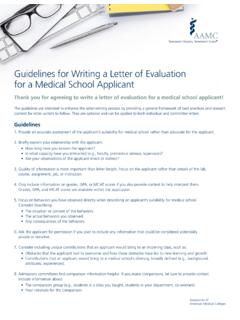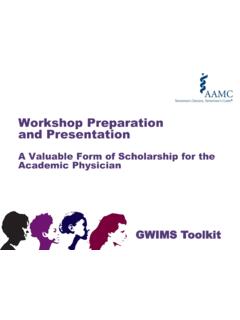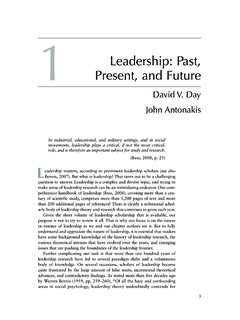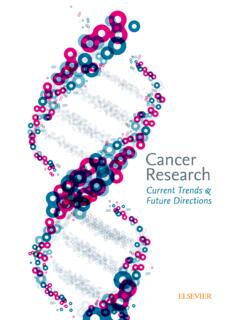Transcription of The Complexities of Physician Supply and Demand ...
1 The Complexities of Physician Supply and Demand : Projections From 2018 to 2033 The Complexities of Physician Supply and Demand : Projections From 2018 to 2033 June 2020 Prepared for the AAMC by IHS Markit Ltd. The Complexities of Physician Supply and Demand : Projections From 2018 to 2033 i Association of American Medical Colleges The Complexities of Physician Supply and Demand : Projections From 2018 to 2033 June 2020 Prepared for the AAMC by IHS Markit Ltd. Association of American Medical Colleges Washington, The Complexities of Physician Supply and Demand : Projections From 2018 to 2033 ii Association of American Medical Colleges This report was prepared for the AAMC by IHS Markit Ltd.: Tim Dall, Executive Director Ryan Reynolds, Senior Consultant Ritashree Chakrabarti, PhD, Senior Consultant Kari Jones, PhD, Director Will Iacobucci, Senior Consultant IHS Markit Ltd. 1300 Connecticut Ave., NW, Suite 800 Washington, DC 20036 2020 Association of American Medical Colleges.
2 May be produced and distributed with attribution for educational or noncommercial purposes only. The Complexities of Physician Supply and Demand : Projections From 2018 to 2033 iii Association of American Medical Colleges CONTENTS EXECUTIVE SUMMARY vi Key Findings vii future directions in Physician Workforce Research viii INTRODUCTION 1 UPDATED PROJECTIONS 3 Total Physician Supply and Demand 4 Primary Care Supply and Demand 5 Non-Primary Care Supply and Demand 7 Medical Specialties 7 Surgical Specialties 9 Primary-Care-Trained Hospitalists 11 Other Specialties 13 Supply MODELING 16 Supply Modeling Inputs, Assumptions, and Scenarios 16 Supply Projections 18 Demand MODELING 21 Demand Modeling Inputs, Assumptions, and Scenarios 21 Population Characteristics and Projections 21 Demand for Health Care Services 22 Patterns of Care Delivery 22 Advanced Practice Registered Nurses and Physician Assistants 23 Scenarios Modeled 26 Demand Projections 29 National Demand 29 Demand by Population Demographics 32 evolving CARE DELIVERY SYSTEM Demand IMPLICATIONS 35 GEOGRAPHIC DISTRIBUTION OF Physician Supply AND Demand 41 Physician Demand by Census Region 41 Physician Demand by Urban-Rural Location 43 PROVIDERS REQUIRED IF ACHIEVED EQUITY IN HEALTH CARE UTILIZATION 46 CONCLUSIONS 49 future directions IN HEALTH WORKFORCE RESEARCH 51 APPENDIX 1: DATA AND METHODS 53 Synopsis of Study Methods 53 Supply Model Overview and Updates 54 Demand Model Overview and Updates 55 APPENDIX 2.
3 ADDITIONAL TABLES AND CHARTS 57 NOTES 70 REFERENCES 71 The Complexities of Physician Supply and Demand : Projections From 2018 to 2033 iv Association of American Medical Colleges EXHIBITS Exhibit ES-1: Total Projected Physician Shortfall Range, 2018-2033 vi Exhibit 1: Projected Physician Supply and Demand by Scenario, 2018-2033 4 Exhibit 2: Total Projected Physician Shortfall Range, 2018-2033 5 Exhibit 3: Projected Supply and Demand for Primary Care Physicians, 2018-2033 6 Exhibit 4: Projected Primary Care Physician Shortfall Range, 2018-2033 7 Exhibit 5: Projected Supply and Demand for Medical Specialist Physicians, 2018-2033 8 Exhibit 6: Projected Medical Specialist Physician Shortfall Range, 2018-2033 9 Exhibit 7: Projected Supply and Demand for Surgeons, 2018-2033 10 Exhibit 8: Projected Surgeon Shortfall Range, 2018-2033 11 Exhibit 9: Projected Supply and Demand for Primary-Care-Trained Hospitalists, 2018-2033 12 Exhibit 10: Projected Primary-Care-Trained Hospitalists Shortfall Range, 2018-2033 13 Exhibit 11: Projected Supply and Demand for Other Specialties, 2018-2033 14 Exhibit 12: Projected Other Specialist Physician Shortfall Range, 2018-2033 15 Exhibit 13: Projected Supply of Physicians, 2018-2033 18 Exhibit 14: Projected Change in Physician Supply : 2020 vs.
4 2019 Report Projections 19 Exhibit 15: Projected Change in Physician Supply by Specialty Category, 2018-2033 20 Exhibit 16: Physician Demand Under Alternative Scenarios of the Degree to Which Advanced Practice Registered Nurses and Physician Assistants Reduce Demand for Physicians, 2018-2033 26 Exhibit 17: Projected Demand for Physicians, 2018-2033 30 Exhibit 18: Projected Change in Physician Demand : 2020 vs. 2019 Report Projections 31 Exhibit 19: Proportion of Physician Demand by Population Aged 65+, 2018 and 2033 32 Exhibit 20: Projected Physician Demand Growth by Patient Race and Ethnicity, 2018-2033 33 Exhibit 21: Physician Demand Implications of evolving Care Delivery System Components by 2033 38 Exhibit 22: Projected Growth in Physician Demand Under Status Quo and evolving Care Delivery System Scenarios, 2018-2033 39 Exhibit 23: evolving Care Delivery System Scenario Demand Projections, 2018-2033 40 Exhibit 24: Physician Primary Care Demand and Demand Growth by Census Region, 2018-2033 42 Exhibit 25: Physician Non-Primary Care Demand and Demand Growth by Census Region, 2018-2033 43 Exhibit 26: Physician Primary Care Demand and Demand Growth by Metropolitan Designation, 2018-2033 44 Exhibit 27.
5 Physician Non-Primary Care Demand and Demand Growth by Metropolitan Designation, 2018-2033 45 Exhibit 28: Current Use of FTE Physician Services per 100,000 Population by Patient Race and Ethnicity, 2018 47 Exhibit 29: Health Care Utilization Equity Scenario 1, 2018 48 Exhibit 30: Health Care Utilization Equity Scenario 2, 2018 48 Exhibit 31: Summary of Demand Modeling Data Sources 56 Exhibit 32: Projected Physician Demand by Patient Race and Ethnicity, 2018-2033 57 Exhibit 33: Projected Physician Demand by Census Region, 2018-2033 58 Exhibit 34: Projected Physician Demand by Urban-Rural Location, 2018-2033 59 Exhibit 35: Summary of Projected Gap Between Physician Supply and Demand , 2018-2033 60 The Complexities of Physician Supply and Demand : Projections From 2018 to 2033 v Association of American Medical Colleges Exhibit 36: Projected Physician Supply , 2018-2033 61 Exhibit 37: Physician Supply Projection Summary by Specialty Category, 2018-2033 62 Exhibit 38: Projected Physician Demand by Scenarios Modeled, 2018-2033 63 Exhibit 39: Additional Physicians Required to Achieve Health Care Utilization Equity in 2018 by Specialty Category 64 Exhibit 40: Additional Physicians Required to Achieve Health Care Utilization Equity in 2018 by Patient Race/Ethnicity 65 Exhibit 41: Additional Physicians Required to Achieve Health Care Utilization Equity in 2018 by Region 66 Exhibit 42: Physician Demand by Health Care Utilization Equity Scenario and Region in 2018 67 Exhibit 43: Additional Physicians Required to Achieve Health Care Utilization Equity in 2018 by Urban/Rural Area 68 Exhibit 44.
6 Physician Demand by Health Care Utilization Equity Scenario and Urban/Rural Area in 2018 69 The Complexities of Physician Supply and Demand : Projections From 2018 to 2033 vi Association of American Medical Colleges EXECUTIVE SUMMARY Assessing the capacity of the nation s future Physician workforce to meet expected Demand provides critical information to both the public and the private sectors. The pace of change in health care coupled with the lead time required to train new physicians necessitates continuously updating and improving workforce projections. For these reasons, since 2015, the AAMC has commissioned annual reports of national Physician workforce projections prepared by independent experts. The purpose of these updates is threefold: Update and improve workforce projections: The AAMC is committed to supporting ongoing efforts to use the most recent and best-quality data to update projections and to respond to constructive feedback received about previous projections.
7 Present new analyses: The reports present new and updated research on the Physician workforce and the implications of important issues such as the evolving health care system, the changing demographic composition of the workforce, and changing hours-worked and retirement patterns. Identify future directions for research: The process of modeling future Supply and Demand for physicians helps identify areas for future research, data collection, and analysis that will strengthen future projections and support decision-making to help align the nation s Physician workforce with its health care needs. This 2020 update was prepared before the COVID-19 crisis, so although it does not include any specific information or scenarios based on that crisis, it does include some lessons learned from the pandemic and critical shortages of health workers. future editions will look at this topic more explicitly. This report uses a modeling approach and data sources similar to those in previous reports.
8 As in the past, this update projects future Physician Supply by considering trends in key Physician Supply determinants and the sensitivity of Supply projections to changes in these determinants. The Demand projections reflect changing demographics as the population grows and ages, the rapidly growing Supply of advanced practice registered nurses (APRNs) and Physician assistants (PAs), and other important trends in health care such as a growing emphasis on achieving population health goals. Because it is impossible to predict with certainty the degree to which any scenario will transpire, the projected shortages are presented as a range under the most likely scenarios rather than as a single number. This year, we updated the workforce projections with new Physician work-hours and retirement-intentions data from the AAMC 2019 National Sample Survey of Physicians (NSSP). Survey findings suggest that physicians intend to retire earlier than was assumed in previous Supply projections.
9 Consequently, projected future Physician Supply is lower than in past reports. This update extrapolates a 2018 level of care delivery to 2033 to project future Demand under the Status Quo Scenario, whereas the previous report extrapolated a 2017 level of care delivery to 2032. The update also reflects the federal Health Resources and Services Administration s upward revision of the number of additional physicians required to remove Health Professional Shortage Area (HPSA) designations for primary care and mental health specialties; this information is used as a conservative proxy for national gaps between Supply and Demand in 2018. Study findings offer stakeholders insights into changes expected in the Physician workforce by 2033. All Supply and Demand projections are reported as full-time-equivalent (FTE) physicians, where an FTE is The Complexities of Physician Supply and Demand : Projections From 2018 to 2033 vii Association of American Medical Colleges defined for each specialty category as the average weekly patient-care hours for that specialty category.
10 The projections include all active physicians who have completed their graduate medical education. Key Findings We continue to project that Physician Demand will grow faster than Supply , leading to a projected total Physician shortage of between 54,100 and 139,000 physicians by 2033 (Exhibit ES-1). This projected shortage range reflects updates to model inputs, including updated estimates of physicians hours-worked patterns and retirement intentions and larger starting-year shortage estimates based on recently revised federal Health Professional Shortage Area (HPSA) designations for primary care and mental health. o A primary care Physician shortage of between 21,400 and 55,200 is projected by 2033. o A shortage of non-primary care specialty physicians of between 33,700 and 86,700 is projected by 2033, including: Between 17,100 and 28,700 for Surgical Specialties. Between 9,300 and 17,800 for Medical Specialties. Between 17,100 and 41,900 for the Other Specialties category.



















